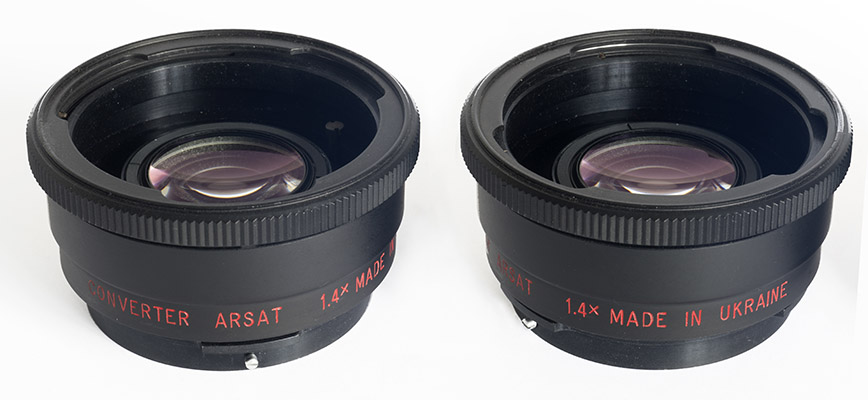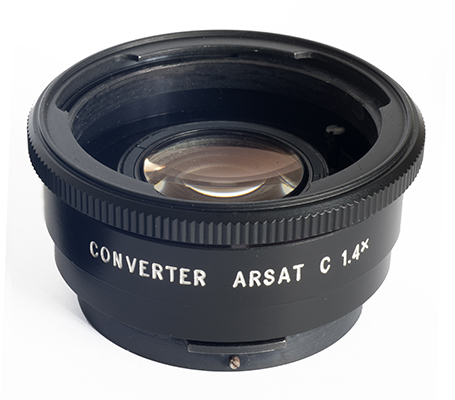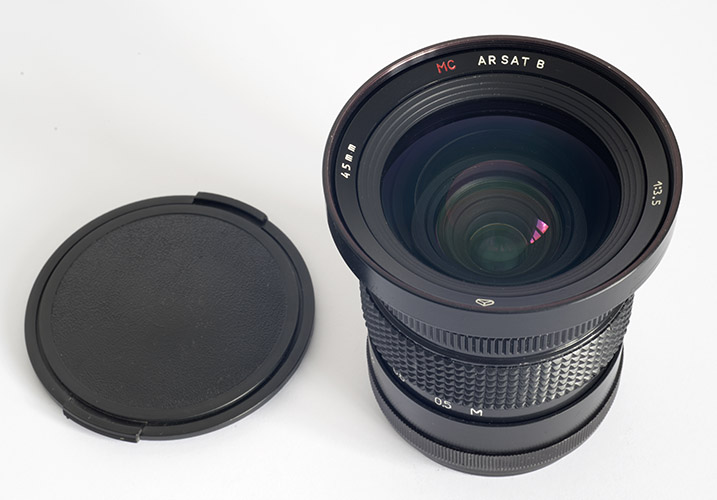by TRA
Lens Data Summary
Arsat lenses
At some point in the
late 1990s, the Arsenal camera and lens factory in Kiev,
Ukraine, started branding its products with the name
“ARSAT”. Unlike the Arsenal factory in the days of
the Soviet Union, Arsat seems to have exercised quality
control on the items that left the factory.
Most Arsenal lenses, possibly all of them, henceforth
appeared bearing the name “ARSAT”.
The 1.4× converter from Arsat
 |
|
 |
It would appear that this 1.4×
converter was made at some time after the one
illustrated on the far left, here. We are of
course not surprised to see the name “ARSAT” (although I
do wonder why it no longer states “MADE IN UKRAINE” –
nor any other place of manufacture). However, we
note that the camera and lens mount has been specified
as “C”. This was clearly part of the
effort to avoid the confusion that was previously caused
on world markets by the labelling of Arsenal lenses
sometimes with the Cyrillic letters for “B” and “V”, and
sometimes with the Roman alphabet letters, to indicate
whether they had the Salyut/Kiev 80/Kiev 88 mount or the
Kiev 60/Pentacon Six mount. |
| Two details of the text on this 1.4×
converter show that it is from the post-Soviet period. 1) It bears the name “ARSAT.” 2) It boldly states “MADE IN UKRAINE” instead of the formerly-used “CCCP”. We also note that it is targeting a market that extends beyond the former Soviet Union, by using the Roman alphabet instead of the Cyrillic one. [1pt4_01.jpg]
|
Some commentators state
that the “C” here is in fact in Cyrillic, in which the
letter written “C” has the sound “S”. According to
these commentators, it stands for “Six” as in “Pentacon
Six”. As the rest of the text is in the Roman
alphabet, I find this conclusion unconvincing.
However, it does not matter; the main thing is to make
sure that the lens or converter has the mount that will
fit one’s camera! [1pt4_02a.jpg]
|
||
| Viewed from a different
angle than in these photographs, it is clear that both
of these versions of the 1.4× converter are
multi-coated, although the coating is different in each
one, showing some greenish reflections, along with
purple, in the converter on the left here, while in the
converter on the right here, the reflections are
principally purple. Both versions of the converter
have the pin that provides automatic operation of the
aperture of the lens used with it. In the
converter on the left, this pin is spring-loaded,
whereas in the converter on the right, this spring has
been dispensed with. We note that in the automatic
extension tubes from Pentacon, the aperture pins are not
spring-loaded, so this is clearly not essential. |
|||
The Arsat 45mm (non-shift) wide-angle lens
| To the best of my knowledge, most
(all?) lenses that were produced by Arsenal for the Kiev
60 had single coating.
However, when the same lenses were manufactured under
the name “ARSAT” most (possibly all) of them were multi-coated.
Here we see a picture of the ARSAT version of the
Mir-26B 45mm wide-angle lens. Note the “MC”
in red letters. (The reflections in the lens
elements when viewed from various angles also confirm
that they are multi-coated.) Interestingly, this particular lens appears not to have a serial number. However, we note that the Arsenal logo was still being used. It is visible on the name ring at the point nearest the viewer in this picture. We also note that this lens has the designation “B”, which was the letter that was at that point being used by Arsat for lenses with the Pentacon Six/Kiev 60 mount. (I therefore conclude that this lens is older than the second converter illustrated above, right.) |
|
 [45mm_MC_Arsat.jpg] |
We report on the 250mm f/5.6 lens with the name “ARSAT” here. Arsat also developed and marketed a new lens that had not been part of the Arsenal lens programme, the 55mm shift lens. We report on it here. The Arsat 55mm shift lens appears to have been made to a much higher standard than the lenses produced during the Soviet era. It is reported to be one of the sharpest lenses available in the Pentacon Six mount. To see a list of shift lenses from Arsenal, Hartblei and Wiese, click here. To see a report on two shift lenses and one shift-tilt lens from Wiese Fototechnik in Hamburg, click here.
In the next section, we look at the Arsat 45mm shift
lens.
Next section (Arsat 45mm shift lens)